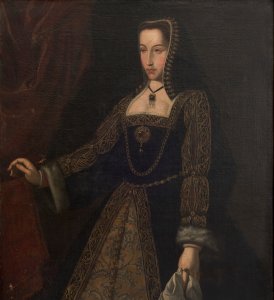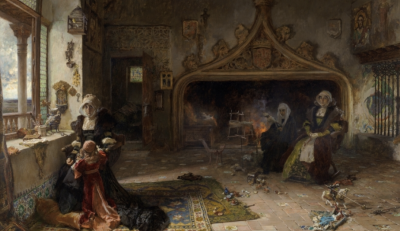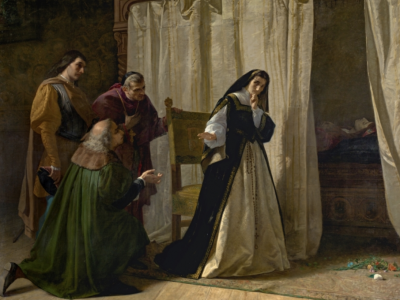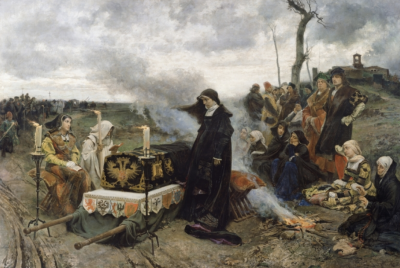Contact Info
Location
65 S. Sandusky St.
Delaware, OH 43015
E djalbon@owu.edu
OWU Connection Programs
Merrick Hall

INTRODUCTION
In this research project - developed for my Spanish 491 Directed Reading focused on Women and Power in Early Modern Spain - I aim to uncover the enigma behind Joanna of Castile’s mental state. Joanna was the queen of Castile (1504) and of Aragon (1516), and the daughter of the Spanish Catholic monarchs, Isabella & Ferdinand. Her profile has been studied for decades due to the uncertainty that surrounds her illness, yet there is still no clear cut answer about the nature of her mental struggles. Hence, the story of her life has sparked my interest and drawn me to seek these answers by combining an interdisciplinary analysis.
Given the lack of first-hand testimonies written by the queen herself, explaining her point of view, ambiguity exists regarding the validity and accuracy of any potential diagnoses. Records from secondary sources show she might have had a degenerative mental illness that became most salient in her early adulthood. Making use of the available evidence, I have created a timeline of relevant events that will serve as evidence for a diagnosis. Sadly, history is tainted by power struggles, especially in the life of Joanna, who’s father and husband tried to deem her unfit to rule given her condition. For this reason, my primary aim is not solely to find a label for Joanna’s behavior but to contribute to the general body of knowledge created until now.
POTENTIAL DIAGNOSIS
Schizoaffective disorder (depressive type)
Beginning at age 16, Joanna started having psychotic symptoms (including delusions, grossly disorganized behavior, as well as hallucinations later on in her life) after moving to Flanders and marrying Philip of Flanders. These symptoms were mostly accompanied by major depressive episodes throughout her adolescence and early adulthood and were exacerbated by abuse and confinement.

Joanna fulfills the diagnostic criteria for schizoaffective disorder. The diagnosis requires symptoms of a major mood disorder, in her case Major Depressive Disorder, and at least two symptoms from Criterion A for Schizophrenia two weeks prior to the onset of the mood disorder. DSM-V criteria consistent with her symptoms are listed below; the information for the disorder only includes the symptoms that Joanna reportedly experienced and not all possible symptoms for the diagnosis (refer to the DSM-V for full criteria).
Schizoaffective disorder DSM-V Diagnostic Criteria
“An uninterrupted duration of illness during which there is a major mood episode (manic or depressive) in addition to criterion A for schizophrenia; the major depressive episode must include depressed mood." (APA 105 6)
Criterion A for schizophrenia
"Two or more of the following presentations, each present for a significant amount of time during a 1-month period (or less if successfully treated). At least one of these must be from the first three below."
Delusions
Hallucinations
Grossly disorganized or catatonic behavior
"Hallucinations and delusions for two or more weeks in the absence of a major mood episode (manic or depressive) during the entire lifetime duration of the illness."
"Symptoms that meet the criteria for a major mood episode are present for the majority of the total duration of the active as well as residual portions of the illness."
"The disturbance is not the result of the effects of a substance (e.g., a drug of misuse or a medication) or another underlying medical condition.” (APA 105 6)
Content of her delusions
Joanna’s delusions mainly centered around her extreme preoccupation with her husband’s infidelities and relationships with other women, even after his death, this was a recurrent symptom of the queen’s psychosis.
“Jealous type: This subtype applies when the central theme of the individual’s delusion is that his or her spouse or lover is unfaithful.” (APA 90)
Major Depressive Disorder DSM-V Diagnostic Criteria
“A. Five (or more)of the following symptoms have been present during the same 2-week period and represent a change from previous functioning: at least one of the symptoms is either (1) depressed mood or (2) loss of interest or pleasure. Note: Do not include symptoms that are clearly attributable to another medical condition."
"Depressed mood most of the day, nearly every day, as indicated by either subjective report (e.g., feels sad, empty, hopeless) or observation made by others (e.g., appears tearful). (Note: In children and adolescents, can be irritable mood.)"
"Markedly diminished interest or pleasure in all, or almost all, activities most of the day, nearly every day (as indicated by either subjective account or observation)."
"Significant weight loss when not dieting or weight gain (e.g., a change of more than 5% of body weight in a month), or decrease or increase in appetite nearly every day. (Note: In children, consider failure to make expected weight gain.)"
"Insomnia or hypersomnia nearly every day."
"Fatigue or loss of energy nearly every day. The symptoms cause clinically significant distress or impairment in social, occupational, or other important areas of functioning."
"The episode is not attributable to the physiological effects of a substance or to another medical condition.” (APA 160 1)
Joanna married Philip I at the age of 16 in 1496, and at first, the couple was thought to have great chemistry. However, shortly after, Joanna became obsessed with her marital duties to the point that her then-husband grew weary of her devotion (Rubio 34). Biographical data compiled by Maria Jose Rubio (2010) would suggest that at this time, she started showing psychotic symptoms, including delusions of jealousy, exacerbated by her husband’s infidelities, and disorganized behavior characterized by unpredictable agitation. Shortly after, her depressive symptoms started, As William Prescott posits in The History of the Reign of Ferdinand and Isabella the Catholic, Joanna fell into a state of deep melancholy, her symptoms fulfill the diagnostic criteria for a major depressive episode. She was said to cry every day, refused to engage in any of her religious duties as well as to bathe or care for her physical appearance. Joanna wouldn’t sleep and would stay inactive for long periods of time (chapter XIII). Given that Joanna moved to a different country accompanied only by her servants, it would be expected that she would have some trouble adjusting. However, her actions were considered so extravagant that her mother Isabel decided to send her personal friar to talk to Joanna, he, later on, informed them of the deplorable state that their daughter was in (Rubio 35).
According to William Prescott, in late 1502, Joanna and Philip traveled to Spain together to visit Isabel and Ferdinand; however, Philip had to return to Flanders to attend business, and Joanna wasn’t allowed to join him due to her advanced pregnancy. Her servants reported that she often threatened them and assured that she would escape and go see Philip by herself, disregarding the fact that there was a threat of war and that she would be putting her and her baby’s life at risk. Her usual jealous delusions had been a constant throughout their marriage, but in his absence, her obsession and symptoms became more severe. After his departure, Joanna started displaying catatonic behavior; she would sit motionless for days with her eyes fixed to the ground. Her depressive symptoms accompanied the psychosis as she was said to be “transported, ” she wouldn’t sleep, eat, or speak more than a few words.

She refused to attend religious duties and would refuse any type of consolation. In early 1503, Joanna gave birth to her second son, but her condition did not improve, her mind was still occupied with returning to Flanders and reuniting with Philip. Reports suggest that her condition kept deteriorating while away from her husband. In the month of November of 1503, for several consecutive nights, Joanna would wander out of the palace undressed and would try to escape to be with Philip. She would have to be persuaded by servants and eventually her mother to come back inside. However, she refused to put clothes on and would stand motionless, shivering for the remainder of the night (ch. XIII).
Due to political conflict and threats of war, Joanna wouldn’t return to Flanders until 1504. Upon her return, she finds out that her husband has been having an affair with one of their servants. Joanna became livid, and she proceeded to hit her and ordered her hair to be shaved. When Philip found out, he physically and verbally abused Joanna and said that he would not speak to her ever again. Regardless of her husband’s lack of interest, she refused to leave his side as this was the only way she could control her bursts of jealousy and incessant preoccupation (Rubio 41).
According to Prescott, in mid-1506, Philip unexpectedly fell ill, and Joanna never left his side during his illness. He ended up passing away in September, and Joanna’s condition worsened again. She never once cried, but she remained in a catatonic state for days, she was said to be immobile as a statue, she wouldn’t speak, eat, or sleep (ch. XIX). In life, Philip expressed that he wanted to be buried in Granada, which is a long journey away from Miraflores, where he passed away. It was determined that his body would be kept in a monastery until Joanna and her servants could begin their journey to his final resting place. Regardless, Joanna would visit her husband every day and would order for his coffin to be unsealed so that she could see and touch her husband’s body for prolonged periods of time. Her delusions of jealousy were pervasive even after he had died; Joanna didn’t allow women to even get near her late husband’s corpse as she said that their presence would be profaning his resting place (ch. XX).
Rumors started to spread about Joanna's mental state, and her father decided that it would be best to keep her locked away first in Santa María del Campo and later on at the Tordesillas palace accompanied by her still unburied husband. Joanna refused to bathe or change clothes. Frequently, she slept on the cold floor and refused to pray or engage in any of her religious duties. All the windows were covered to keep Joanna from escaping, but also to keep people from hearing her screaming and snapping at her servants. Joanna was made a prisoner in her own home, no visitors were allowed in the palace, and her father consented her guard Mosén Luis Ferrer to physically punish her when she refused to bathe, eat, or get dressed (Rubio 53).

Joanna was held captive in deplorable conditions for over 40 years. During her final years, she displayed symptoms of major depression accompanied by psychosis. The queen started having hallucinations, which she described as malignant visions and would refer to her servants as witches. She would refuse to eat and would sleep on the cold floor almost nightly. Joanna rejected religion and would display inappropriate affect during religious ceremonies; she would make bizarre facial expressions and provocative gestures, leading some to believe that she had been possessed. Her behavior would either be extravagant in this way or catatonic (Rubio 57-61).
In her last few days, Joanna negated catholicism and refused to go through with confession and communion before her death.
She passed away on the 12th of April of 1555 at the age of 76.
Given the available evidence, I believe that Joanna’s symptoms are consistent with Schizoaffective disorder, as historians have suggested. There are many factors to consider, though, and these conclusions are in no way definitive nor will they ever be. Assessments of this kind are done, at least currently, taking into consideration the client’s input and their perspective. In the case of Joanna, it would be impossible to directly ask her about her experience and symptoms, given that she lived over 500 hundred years ago. Sadly, even if this had been possible, there was no available treatment at the time for such conditions; hence Joanna’s mental health would’ve likely deteriorated in the same way it did. While I was collecting relevant data for this project, I was surprised that I didn’t come across anything resembling this investigation. There are many diagnoses available but little proof to back up the information, making it challenging for me to decipher the rationale for the labels that they assigned to Joanna.

Nevertheless, I believe that even my conclusions based on data by historians should be taken with a grain of salt, as there are many more elements that could’ve played a role in the development of her illness. It is essential to recognize that the queen possibly inherited vulnerable genes from her maternal grandmother, who was believed to have had a similar but more severe psychotic disorder than Joanna. Aside from this, at the young age of 16, she was forced to marry and move away from her home, leaving behind her family and the life that she had known. Her husband Philip and her father physically and emotionally abused Joanna, and even after their passing, she was held against her will for over 40 years, once more becoming a victim of neglect and violence. It is true that regardless of the hardships that she had to withstand, her behavior was maladaptive before these events. However, I think that it would be extremely biased on my behalf not to consider these external factors as crucial when thinking about her illness. Even nowadays, mental health conditions are incredibly stigmatized; therefore, I can’t even imagine the amount of prejudice that even Joanna’s own family had toward her that they recurred to locking her away forever as a solution. My main goal with this research was to shed some light on the queen’s case utilizing available biographical data compiled by historians and researchers. The fact that Joanna is still widely known as “Joanna the mad” is genuinely upsetting and only serves as a reinforcer for our current negative biases about individuals with mental health conditions. I want my work to contribute to the general body of knowledge and to provide some relevant information so that Joanna’s case can be approached and talked about with more compassion and understanding.
American Psychiatric Association, and American Psychiatric Association. DSM-5 Task Force. Diagnostic and Statistical Manual of Mental Disorders: DSM-5. American Psychiatric Association, Washington, D.C, 2013.
Pantoja de la Cruz, Juan. “Juana La Loca.” Juana La Loca, Museo Nacional Del Prado, 1848, https://www.museodelprado.es/coleccion/obra-de-arte/juana-la-loca/1a3e8f13-a819-4ed1-8dc0-73fd4657cdc2.
Pradilla y Ortiz, Francisco. “La Reina Doña Juana La Loca, Recluida En Tordesillas Con Su Hija, La Infanta Doña Catalina.” La Reina Doña Juana La Loca, Recluida En Tordesillas Con Su Hija, La Infanta Doña Catalina, Museo Nacional del Prado, 1906, https://www.museodelprado.es/coleccion/obra-de-arte/la-reina-doa-juana-la-loca-recluida-en/2687023e-7056-4290-babf-8b2879f07827.
Pradilla y Ortiz, Francisco. “Doña Juana La Loca.” Doña Juana La Loca, Museo Nacional Del Prado, 1877, https://www.museodelprado.es/coleccion/obra-de-arte/doa-juana-la-loca/74bffb8f-dfd0-431f-88a9-eed8cb2b578f.
Prescott, William Hickling. History of the Reign of Ferdinand and Isabella the Catholic Volume 3. Rarebooksclub Com, 2012.
Rubio María José. Reinas De España, Las Austrias: Siglos XV-XVII, De Isabel La Católica a Mariana De Neoburgo. La Esfera De Los Libros, 2015.
Vallés, Lorenzo. “Demencia De Doña Juana De Castilla.” Demencia De Doña Juana De Castilla, Museo Nacional Del Prado, 1866, https://www.museodelprado.es/coleccion/obra-de-arte/demencia-de-doa-juana-de-castilla/6ffe5b1e-ded1-4ff8-ab1a-f87c601d5591.